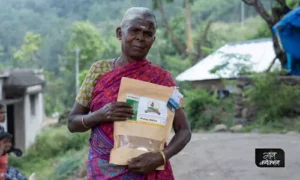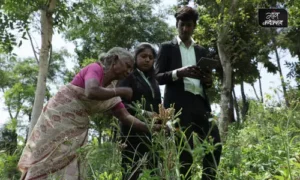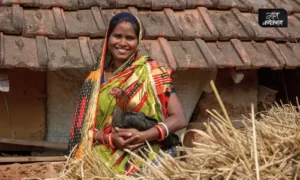In the wake of lower than expected sowing of paddy in the key rice producing states due to low rainfall this monsoon season, yesterday, on September 8, the Union Ministry of Finance announced a 20 per cent tax on the export of non-basmati and non-parboiled rice. The same day, the Directorate General of Foreign Trade (DGFT) prohibited the export of broken rice.
However, the decisions to curb the export of rice have miffed the exporters of rice in the country who have cited multiple reasons as to how the export restrictions can harm not only the interests of farmers and traders but also India’s commercial outreach in the offshore markets.
When Gaon Connection contacted Vinod Kaul, executive director of the New Delhi-based All India Rice Exporter’s Association to get insight about the long-term implications of these curbs on the export of rice, it was learnt that the possibility of offshore markets looking for suppliers elsewhere is the biggest concern.
India is the world’s largest exporter of rice with a share of 40%. The Indian govt has announced curbs on rice exports and imposed 20% export tax on non-basmati & non-parboiled rice exports.
On Sept 3, @GaonConnection had reported on a possible ban
https://t.co/mjSzJMYRR2 pic.twitter.com/eM6cx2kjZr
— Gaon Connection English (@GaonConnectionE) September 8, 2022
“Historically, the on and off export policies with regards to export of other food commodities like onion and potato dented India’s business interests in offshore markets. All these decisions had damaging implications for India,” Kaul said.
“But now, since India is the leading exporter of rice, the whole world was looking at us for their supplies and we had a considerable edge in the world market as our prices were competitive. These decisions to curb exports will have consequences as there will be a dent in our image of being able to provide rice regularly and countries might look for rice imports from elsewhere,” he added.
Also Read: Will India ban rice exports? Here’s what rice traders and exporters say
Meanwhile, Vishal Tiwari, a rice exporter from Uttar Pradesh’s Mirzapur who exports rice to countries in south-Aast Asia, is miffed at the government for not providing a time window for the implementation of the curbs on exports.
“They should have at least given a week’s time or a month’s time for the export restrictions. They should have cared for exporters who have commitments to deliver the stocks to other countries. Also, these restrictions will also impact farmers and domestic traders as the rice prices will fall drastically in the event of reduced exports,” Tiwari told Gaon Connection.
![According to the rice exporters's association, the demand for foodgrains induced by the free ration distribution schemes like Pradhan Mantri Garib Kalyan Anna Yojana [PMGKY] are also amongst the reasons that might have formed the rationale to curb rice exports. According to the rice exporters's association, the demand for foodgrains induced by the free ration distribution schemes like Pradhan Mantri Garib Kalyan Anna Yojana [PMGKY] are also amongst the reasons that might have formed the rationale to curb rice exports.](https://en.gaonconnection.com/wp-content/uploads/2024/08/361446-rice-export.webp)
According to the rice exporters’s association, the demand for foodgrains induced by the free ration distribution schemes like Pradhan Mantri Garib Kalyan Anna Yojana [PMGKY] are also amongst the reasons that might have formed the rationale to curb rice exports.
The exporter agreed with Kaul’s remarks on offshore markets diverting their orders towards other rice-producing countries.
“That is bound to happen. Such change in export policies disturb the market interests of not just the exporters like me but the national interests at large. Nobody, be it an individual or a country, wants to rely on a supplier whose supply is erratic and unreliable,” he told Gaon Connection.
Significant losses from prohibition on broken rice exports
Kaul, the senior representative from rice exporters’ association told Gaon Connection that last year, India exported 38 lakhs tonnes [3.8 million tonnes; 1 tonne = 1,000 kilogrammes] of broken rice while as per the data compiled so far by the association this year, India has exported only 20 lakh tonnes [2.8 million] of broken rice.
“A tonne of broken rice is exported at a price of USD 380 [United States Dollar]. So, the loss in terms of losses from exports on broken rice is significant,” Kaul told Gaon Connection.
‘Ethanol production a contributing factor to rice export curbs’
Ideally, broken rice is not used for human consumption. When asked about what he thinks has led the government to prohibit the export of broken rice, Kaul stated that the government’s initiative to blend petrol with ethanol could be a decisive factor.
“The government may have limited the export of broken rice because their focus is now on the production of ethanol which is used in the blending of petrol. Broken rice is best suited for ethanol production because it is not used for human consumption,” Kaul said.

“Energy security is a big issue today. We cannot easily import crude oil from Iran due to sanctions imposed by the United States. From Russia, we are importing crude oil at a cheaper price but for how long, there is no guarantee. The geopolitical situation [Ukraine war] keeps changing. So safeguarding energy security by blending ethanol with petrol is also a contributing factor
According to the rice exporters’s association, the demand for foodgrains induced by the free ration distribution schemes like Pradhan Mantri Garib Kalyan Anna Yojana [PMGKY] are also amongst the reasons that might have formed the rationale to curb rice exports.
Low production, reduced acreage of rice fueling worries
According to the progress report of the area coverage under kharif (summer) crops released by the Union Ministry of Agriculture and Farmers’ Welfare, as on August 26, there is a reduction of 2,345,000 hectares of paddy’s sowing area in the country as compared to last year’s acreage, which translated as a shortfall by 7.56 per cent. The reduction in the sowing area is attributed to a rainfall deficit in the major rice producing states situated in the Indo-Gangetic plains. A large number of farmers in the country depend on the monsoon rainfall to grow crops as they lack other irrigation facilities.

Data by India Meteorological Department (IMD) shows that between June 1 and September 9 this year, Uttar Pradesh has registered a rainfall deficit of minus 46 per cent. In the neighbouring state of Bihar, the rainfall deficit is minus 36 per cent and in Jharkhand it is minus 27 per cent.
As per news reports, not independently verified by Gaon Connection, the rice production in India this year is likely to fall by seven million tonnes to 12 million tonnes.
“However, with exports of 212 LMT [lakh million tonnes; 1 lakh= 100,000] last year, we can say that India is still surplus in rice production. Around 150 LMT is still surplus. It is early to say how much production will be affected due to poor rains,” he added, saying that there are places which have had surplus rains, which may see more yield which may compensate for production loss,” Sudhanshu Pandey, Food Secretary in the Food and Public Distribution Department was quoted.


















